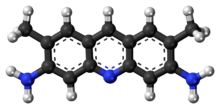Acridine yellow
 | |
 | |
| Names | |
|---|---|
| IUPAC name
2,7-Dimethylacridine-3,6-diamine | |
| Other names
2,7-Dimethylproflavine Acridine yellow G | |
| Identifiers | |
3D model (JSmol) |
|
| 5-22-11-00340 | |
| ChEBI | |
| ChEMBL | |
| ChemSpider | |
| ECHA InfoCard | 100.001.947 |
| EC Number | 202-141-5 |
| MeSH | Acridine+yellow |
PubChem CID |
|
| RTECS number | AR8790000 |
| |
| |
| Properties | |
| C15H15N3 | |
| Molar mass | 273.30 g/mol |
| Appearance | Brown/red crystals |
| Hazards | |
EU classification (DSD) (outdated) |
Harmful (XN) |
| R-phrases (outdated) | R20/21/22, R36/37/38, R68 |
| S-phrases (outdated) | S26, S36/37/39 |
| R/S statement (outdated) | R:R1, R2 S:(S1), (S2) |
| NFPA 704 | |
Except where otherwise noted, data are given for materials in their standard state (at 25 °C [77 °F], 100 kPa). | |
| Infobox references | |
Acridine yellow, also known as acridine yellow G, acridine yellow H107, basic yellow K, and 3,6-diamino-2,7-dimethylacridine, is a yellow dye with strong bluish-green fluorescence. It is a derivate of acridine. In histology, it is used as a fluorescent stain, and as a fluorescent probe for non-invasive measurements of cytoplasmic pH changes in whole cells. It is also used as a topical antiseptic. It is usually available as a hydrochloride salt. Acridine yellow damages DNA and is used as a mutagen in microbiology.
Acridine yellow is similar to acridine orange.
External links
This article is issued from
Wikipedia.
The text is licensed under Creative Commons - Attribution - Sharealike.
Additional terms may apply for the media files.
